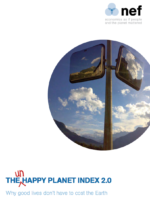The Happy Planet Index 2.0
Why good lives don’t have to cost the Earth
21 June 2009
The Happy Planet Index provides a new compass to set society on the path to real progress by measuring what truly matters to us — living a long and happy life — and what matters to the planet — our rate of resource consumption.
In an age of uncertainty, society globally needs a new compass to set it on a path of real progress. The Happy Planet Index (HPI) provides that compass by measuring what truly matters to us – our well-being in terms of long, happy and meaningful lives – and what matters to the planet – our rate of resource consumption.
The HPI brings them together in a unique form which captures the ecological efficiency with which we are achieving good lives. This report presents results from the second global HPI. It shows that we are still far from achieving sustainable well-being, and puts forward a vision of what we need to do to get there.
Not since World War II has society globally been faced with so many threats. In the last few years we have driven straight into the wall of the biggest global economic downturn since the Great Depression of 1929, whilst mainstream culture has, at last, been rudely awoken to the ever-growing threats of climate change and the exhaustion of our natural resources. People fear for the future. Meanwhile, the problems that plagued us before, risk becoming even more acute: more than half the world’s population lives on less than $2.50 a day; inequality continues to rise even in richer countries.
And yet, with crisis comes opportunity. The dogmas of the last 30 years have been discredited. The unwavering pursuit of economic growth – embodied in the overwhelming focus on Gross Domestic Product (GDP) – has left over a billion people in dire poverty, and has not notably improved the well-being of those who were already rich, nor even provided us with economic stability.
Instead it has brought us straight to the cliff edge of rapidly diminishing natural resources and unpredictable climate change. No wonder that people are desperately seeking an alternative vision to guide our societies. In 2008, Americans voted for ‘change’ and ‘hope’ above else.
The HPI was launched in July 2006 as a radical departure from our current obsession with GDP. Working from first principles, the report identified health and a positive experience of life as universal human goals, and the natural resources that our human systems depend upon as fundamental inputs. A successful society is one that can support good lives that don’t cost the Earth. The HPI measures progress towards this target – the ecological efficiency with which happy and healthy lives are supported.
Its message resonated with hundreds of thousands of people around the world – within two days of its launch, the report was downloaded and read in 185 countries worldwide. Three years on, it is time to turn interest into action.
HPI 2.0 has been calculated with new improved data sets for 143 countries, covering 99 per cent of the world’s population. Scores range from 0 to 100 – with high scores only achievable by meeting all three targets embodied in the index – high life expectancy, high life satisfaction, and a low ecological footprint.
The results turn our idea of progress on its head. Whilst the HPI confirms that the countries where people enjoy the happiest and healthiest lives are mostly richer developed countries, it shows the unsustainable ecological price we pay. It also reveals some notable exceptions – less wealthy countries, with significantly smaller ecological footprints per head, having high levels of life expectancy and life satisfaction. In other words, it shows that a good life is possible without costing the Earth.
The highest HPI score is that of Costa Rica (76.1 out of 100). As well as reporting the highest life satisfaction in the world, Costa Ricans also have the second-highest average life expectancy of the New World (second only to Canada). All this with a footprint of 2.3 global hectares. Whilst this success is indeed impressive, Costa Rica narrowly fails to achieve the goal of ‘one-planet living’: consuming its fair share of natural resources (indicated by a footprint of 2.1 global hectares or less).
- Of the following ten countries, all but one is in Latin America. The highest ranking Group of 20 (G20) country in terms of HPI is Brazil, in 9th place out of 143. Together, Latin American and Caribbean nations have the highest mean HPI score for any region (59 out of 100).
- The bottom ten HPI scores were all suffered by sub-Saharan African countries, with Zimbabwe bottom of the table with an HPI score of 16.6 out of 100.
- Rich developed nations fall somewhere in the middle. The highest-placed Western nation is the Netherlands – 43rd out of 143. The UK still ranks midway down the table – 74th, behind Germany, Italy and France. It is just pipped by Georgia and Slovakia, but beats Japan and Ireland. The USA comes a long way back in 114th place.
- It is interesting to note that many of the countries that do well are composed of small islands (including the Dominican Republic, Jamaica, Cuba and the Philippines).
- No country successfully achieves the three goals of high life satisfaction, high life expectancy and one-planet living.
In summary, the countries that are meant to represent successful development are some of the worst-performing in terms of sustainable well-being. But perhaps, even if we are not there now, might we be moving in the right direction? HPI 2.0 tests this by looking at changes in HPI over time for countries where more data is available. The results are not promising:
- Whilst most of the countries studied have increased their HPI scores marginally between 1990 and 2005, the three largest countries in the world (China, India and the USA) have all seen their HPI scores drop in that time.
- Positive trajectories are seen in some countries; for example, in Germany (an increase of 23 per cent between 1990 and 2005), Russia (up 30 per cent) and Brazil (up 13 per cent).
- Looking further back, focusing on OECD (Organisation of Economic Co-Operation and Development) nations, the picture is less positive. Most OECD nations saw a staggering drop in their HPI scores from the 1960s to the late 1970s. Whilst they have made some gains since then, scores were still higher in 1961 than in 2005. Life satisfaction and life expectancy combined have increased 15 per cent over the 45-year period from 1961 to 2005, but ecological footprints per head have increased by a worrying 72 per cent.
Clearly, business as usual will not help us achieve good lives that do not cost the Earth. However, looking at the components of the HPI provides some clues:
- Different countries do well on different components. The highest average levels of life expectancy are those of Japan (82.3 years) and Hong Kong (81.9). The highest life satisfaction levels are those of Costa Rica (8.5 on a scale of 0 – 10), with Ireland, Norway and Denmark just behind. The countries which tread heaviest in terms of ecological footprint are Luxembourg, the United Arab Emirates and the USA – Luxembourg’s per capita footprint is equivalent to consuming natural resources as if we had almost five planets to rely on.
- It is possible to live long, happy lives with a much smaller ecological footprint than found in the highest-consuming nations.For example, people in the Netherlands live on average over a year longer than people in the USA, and have similar levels of life satisfaction – and yet their per capita ecological footprint is less than half the size (4.4 global hectares compared with 9.4 global hectares). This means that the Netherlands is over twice as ecologically efficient at achieving good lives.
- More dramatic is the difference between Costa Rica and the USA.Costa Ricans also live slightly longer than Americans, and report much higher levels of life satisfaction, and yet have a footprint which is less than a quarter the size.
- Countries with the same ecological footprint support lives with differing levels of well-being and health. For example, Vietnam and Cameroon have identical ecological footprints (1.3 global hectares). However, whilst most people in Cameroon cannot expect to live more than 50 years, and reported life satisfaction is unsurprisingly low (3.9), the Vietnamese have a life expectancy higher than that found in many European countries (73.7 years) and a correspondingly higher level of life satisfaction (6.5).
Steps towards a happier planet can be found in many places. We focus on a few examples, several inspired by the first HPI report. One particularly promising model, is the Living better, using less strategy emerging in Caerphilly, a local authority in South Wales. The strategy focuses on the three components of the HPI – health, a positive experience of life, and ecological footprint – and sets out some interventions aimed to improve performance on all three.
Of course, each thread of work towards a happier planet needs to be woven together to create a full tapestry. The economy, communities, lifestyles and aspirations of a happy planet will be very different to those that lock us into our current ecological inefficiency. The analyses in this report suggest that the current dominant economic framework is, without exception, unable to simultaneously achieve the three goals of high life satisfaction, high life expectancy and one-planet living. This applies across the development spectrum as traditionally viewed, although it appears that middle-income countries, such as those of Latin America and South East Asia tend to be the closest to achieving sustainable well-being. In other words, our current framework achieves its optimum at middle-income levels, but even that optimum does not represent good lives that do not cost the Earth.
We do not, in this report, claim to provide answers to all the questions of what a happy planet would look like. However, at the end of the report, we make some suggestions of the strategies required to achieve sustainable well-being. The solutions suggested all constitute win-win strategies – increased well-being and reduced ecological footprint. In this way, the HPI presents a positive image of futures which countries will actively choose to create for themselves, rather than a necessary burden that must be sustained and endured.
At www.happyplanetindex.org, we launch a new Charter for a Happy Planet. Those who sign it believe that:
- A new narrative of progress is required for the twenty-first century.
- It is possible to have a good life without costing the Earth.
- Over-consumption in rich countries represents one of the key barriers to sustainable well-being worldwide and that governments should strive to identify economic models that do not rely on constantly growing consumption to achieve stability and prosperity.
They call for:
- Governments to measure people’s well-being and environmental impact in a consistent and regular way, and to develop a framework of national accounts that considers the interaction between the two so as to guide us towards sustainable well-being.
- Developed nations to set an HPI target of 89 by 2050 – this means reducing per capita footprint to 1.7 global hectares, increasing mean life satisfaction to eight (on a scale of 0 to 10) and continuing to increase mean life expectancy to reach 87 years.
- Developed nations and the international community to support developing nations in achieving the same target by 2070.
Times of crisis are times of opportunity. Now is the time for societies around the world to speak out for a happier planet, to identify a new vision of progress, and to demand new tools to help us work towards it. The HPI is one of these tools, but we also hope that it will inspire people to act.
Topics Climate change Energy Wellbeing







